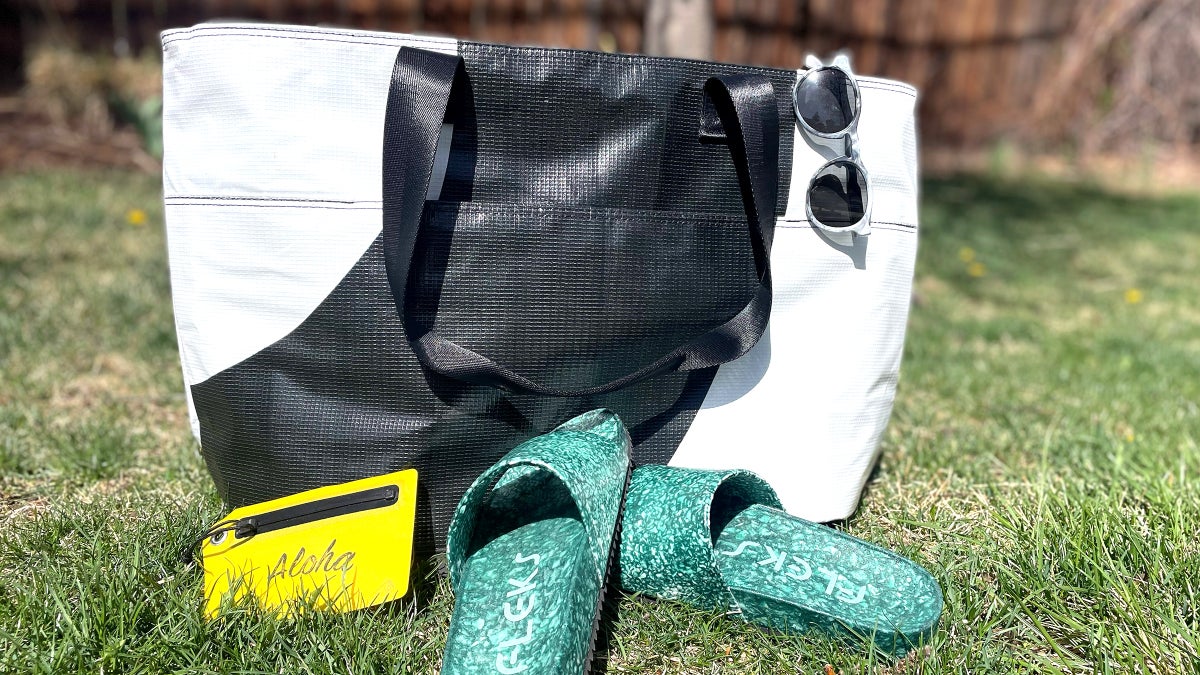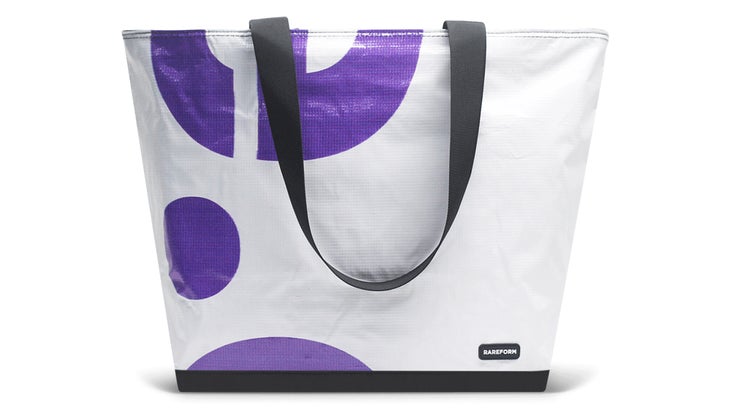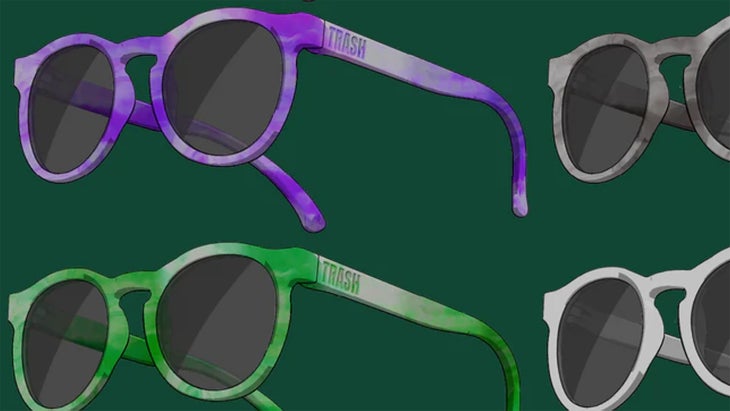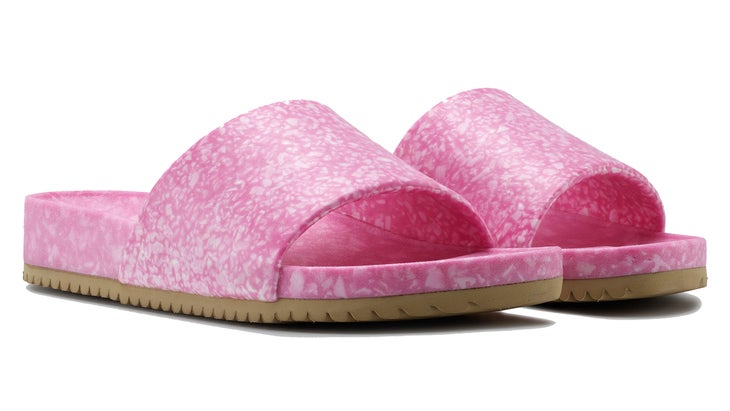
An increasing number of smart, eco-conscious entrepreneurs are putting Earth first by utilizing unwanted materials that would otherwise end up as trash. From trendy tote bags and fanny packs made out of billboard vinyl to casual and recovery footwear made from leftover running shoe midsole scraps, the following four companies are doing their best to keep our planet’s landfills and oceans from overflowing with trash. In the process, they’re creating awesome gear.

Rareform Bags
Rareform Bags caught my attention by infiltrating my Instagram account. Intrigued, I reached out to the company to learn that while traveling in El Salvador, Alec Avedissian saw locals utilizing the water-resistant, durable material that covers billboards for roofing. Alec and his brother, Aric, launched Rareform in 2013 with a surfboard bag made from discarded billboard material. They’ve since expanded to tote bags, hip packs, and other bags out of brightly colored vinyl that isn’t traditionally recyclable.
“The lifespan of a billboard typically is around four to six weeks,” says Alec Avedissian, who also serves as CEO of the company. “When the billboards come down, we then work with our partners to get them shipped to our warehouses in Thousand Oaks, California, and Nashville, Tennessee.”
The company has since kept 700,000 billboards, which amounts to over 30 million pounds of material, out of the landfills by repurposing them as bags.
I’ve been testing the Zippered Blake Tote ($80) and love its large capacity, multiple pockets, zippered closure, and waterproof exterior in a one-of-a-kind design for traveling. I can also see myself using this bag for summer adventures as a “throw everything in and figure out what I need on the way to the trailhead” type of bag.

Trash Gear Co.
Pete Grunwald started collecting discarded plastic “as a fun side project” in 2021 while he was working full time as an industrial designer creating protective eyewear for military applications. He’d break down plastic waste in a blender and use a panini press to mold the pieces into something new: bicycle fenders. He now collects and molds plastic full time with his company Trash Gear Co., which continues to make fenders and is soon releasing sunglasses with frames made from repurposed plastic.
“A big source of my plastic waste is Pak-Techs (plastic can carriers) and I work with beer distributors, breweries, and various stores to collect used ones that customers bring back,” he explains. “I have a whole host of smaller sources of plastic as well, much of it coming from friends and community members who are excited by what I’m doing and set aside waste plastic for me.”
After working in the outdoor industry for years, a vendor trip to China opened his eyes to the environmental impacts of traditional manufacturing and, coupled with his knowledge of the massive amount of waste plastic being produced domestically, pushed him toward the Trash Gear concept. “That trip sparked the idea: What if a company could collect local waste and turn it into high quality outdoor gear?” Grunwald says.
While Grunwald says he’s loved using kitchen tools and figuring things out on the fly, he adds: “One day I hope Trash Gear Co will have a proper manufacturing space and truly be an example of a better way to produce great products.”
I’ve been testing a sample of Trash Gear Co. sunglasses and love their unique frame coloration—the swirled pattern of the plastic reminds me that they kept something out of the landfills.

Think Blue Surf Bag
Designed to keep your key, key fob, credit card, cash, or anything small completely dry while you surf, SUP, kayak, or play in the water, the Surf Bag is made out of aviation life vests that would otherwise end up in a landfill.
Co-founders Marlene Smith and Cathy Chin used to fuel their surfing sessions with Ziploc bags full of cookies—not very successfully. They tried making more functional waterproof bags out of various materials before finding a solution in aviation life vests. Smith, who is a private pilot, and her husband, who works in aircraft maintenance, knew that the life vests were discarded after some of their components expired, while the material of the vest itself, having been stored in an airtight bag in the dark, was still as good as new.
“Approximately 5,000 life vests have been diverted from the landfill into our inventory,” says Smith. “Of those, so far 2,000 have been converted into The Surf Bag. Every time someone chooses to purchase The Surf Bag over a product made from new plastic, they are making a direct impact on the environment by participating in this diversion.
“My dream is to ultimately divert all the retired life vests from the landfill into a variety of high-quality waterproof products making it easy for consumers to choose a sustainable product over new plastic products and allowing them to directly contribute to sustainability.”
The small bag lies flat in board shorts pockets and can be connected to a surfboard or SUP leash tie, or to kayak straps or a backpack with a carabiner.

Fleks Footwear
Fleks Footwear founder Leah Larson says the ocean has always been her happy place. “I used to go jump in the ocean before high school if I was in a bad mood,” she says. After years in the footwear industry, including a long stint as the VP of Product and Creative Director of Ugg, Larson wanted to find a way to reuse the discarded waste from footwear manufacturing while also solving the wastefulness of flip flops, which become toss-away rubber and plastic. Her love of the ocean inspired her to minimize footwear manufacturing leftovers and discarded beach shoes. She teamed up with a friend and past co-worker, Stuart Jenkins, founder of Blumaka insoles, to launch Fleks Footwear.
Fleks (and Blumaka) grind up footwear manufacturing waste—ETPU scraps left over from the midsole manufacturing process—and shape the conglomerate material into slides, clogs, and other casual and recovery footwear. Larson says there’s enough discarded manufacturing foam waste in the footwear industry to make two and a half billion pairs of midsoles for Fleks shoes. Plus, says Larson, “This process uses no solvents and a lot less water than traditional manufacturing.”
I’ve been testing the East Beach Slide, and while they might not be as plush underfoot as my son’s Yeezy Slides that I occasionally steal, I love how my feet stay put on the footbed. Larson chalks that up to the tiny bits of repurposed foam that morph around the foot.
I also love the flecked rubber; it reminds me that my slides kept discarded waste out of the landfills and the ocean, which, like Larson, I’d like to keep healthy. (Larson and I graduated together from the same San Diego high school and used to jump into the same stretch of ocean before classes started.)
The post This Great Gear is Made Out of Trash appeared first on Outside Online.















